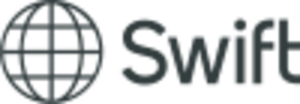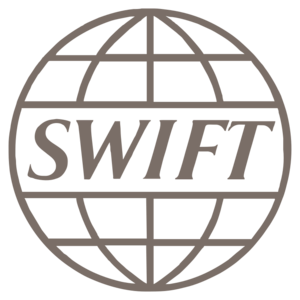SWIFT facts for kids
 |
|
| Cooperative society | |
| Industry | Telecommunications |
| Founded | May 3, 1973 |
| Headquarters | |
|
Key people
|
|
| Products | Financial telecommunication |
|
Number of employees
|
>3000 |
SWIFT stands for the Society for Worldwide Interbank Financial Telecommunication. It's a special group started in 1973 in Belgium. Banks and other financial companies that use its services own SWIFT.
SWIFT provides the main way for banks to send messages to each other about international payments. Think of it like a super-secure messaging service for money. It also sells computer programs and services to banks. SWIFT also gives out special codes called "Swift codes" (or BICs) that help identify banks around the world.
By 2018, about half of all big international payments used the SWIFT network. In 2015, over 11,000 financial groups in more than 200 countries were connected. They exchanged over 32 million messages every day! SWIFT's main office is in La Hulpe, near Brussels.
Contents
How SWIFT Started
Before SWIFT, banks used a system called Telex to send messages about money. This system was slow and involved a lot of manual work. Some banks worried that one big American bank, First National City Bank (now Citibank), had too much control over global money messages.
So, other banks in the US and Europe wanted a new, faster way to send messages. They wanted a system that wasn't controlled by just one company. SWIFT was founded in Brussels on May 3, 1973, to solve this problem.
Many bankers helped create SWIFT. It started with support from 239 banks in 15 countries. SWIFT quickly began setting up common rules for financial messages. They also built a shared computer system and a worldwide communication network. The very first message was sent on May 9, 1977, by Prince Albert of Belgium.
In 1979, SWIFT opened its first office outside Europe in Virginia, USA. In 1989, SWIFT finished building its large main office in La Hulpe.
Who Owns and Runs SWIFT
SWIFT is owned by the banks that use it. The ownership shares are adjusted every three years. This means that the banks that use SWIFT the most have a bigger say. This system also makes sure that different parts of the world are represented.
A board of 25 directors manages SWIFT. These directors are elected by the banks that own SWIFT. They serve for three years, with some new directors joining each year. All directors represent the member banks.
Many big banks from around the world are part of SWIFT's board. This includes banks like JPMorgan Chase, Bank of China, Deutsche Bank, and HSBC.
How SWIFT Works
SWIFT acts like a secure messenger service for banks. It carries messages that tell banks how to make payments. However, SWIFT itself does not hold money or manage bank accounts. It also doesn't handle the final steps of moving money between accounts.
After a payment message is sent through SWIFT, the actual money transfer happens through other systems. For example, in Europe, a system called T2 helps settle payments. For international payments, banks often use special accounts they have with each other.
SWIFT is important in the financial world for a few reasons:
- It's a very secure network for sending messages between banks.
- It has special rules for how financial messages should be written. This helps all banks understand each other.
- It provides computer programs and services that help banks connect to its network.
SWIFT offers different tools to help banks connect. These tools allow banks to send and receive messages safely. Some of these tools help banks manage their messages and connect to other services.
SWIFT Services
SWIFT offers services in four main areas for financial markets:
- Securities: This involves buying and selling stocks and bonds.
- Treasury and derivatives: This deals with managing a company's money and financial agreements.
- Cash management: This helps banks manage their money and payments.
- Trade services: This supports international trade transactions.
SWIFT also has a service called Swift Ref. This service provides important information about banks and codes used in payments. It gets this information directly from central banks and other official sources.
SWIFT's Data Centers
The SWIFT network runs from three main computer centers. These centers are located in the United States, the Netherlands, and Switzerland. They constantly share information with each other. If one center has a problem, another can take over to keep the network running. SWIFT uses special underwater cables to send its data around the world.
In 2009, SWIFT set up a new system with two main zones for messages: European and Trans-Atlantic. Messages from European SWIFT members are stored in the Netherlands and part of the Swiss center. Messages from the Americas and other regions are stored in the US and another part of the Swiss center. This helps keep data organized and secure.
| SN | SWIFT data centers | Type |
|---|---|---|
| 1 | Zoeterwoude, Netherlands | OPC (Operating Centre) |
| 2 | Culpeper, Virginia, United States | OPC (Operating Centre) |
| 3 | Diessenhofen, Switzerland | OPC (Operating Centre) |
| 4 | Hong Kong | Command and control |
The SWIFTNet Network
SWIFT updated its network to a new system called SWIFTNet between 2001 and 2005. This new system uses modern internet technology. It helps messages travel more efficiently.
SWIFT provides a central system that stores and forwards messages. If Bank A wants to send a message to Bank B, it formats the message and sends it securely to SWIFT. SWIFT then makes sure the message is delivered safely and reliably to Bank B. SWIFT ensures this by having many backup systems and people.
Around 2007 and 2008, SWIFT updated its network again to SWIFTNet Phase 2. This update made the network even more secure. It required banks to use a new system called RMA (Relationship Management Application) for connecting. This new system is safer and easier to update. RMA fully replaced the old system by January 1, 2009.
SWIFT Standards
SWIFT has created the standard way for financial messages to be written. This means that many financial systems can understand and process messages that follow SWIFT's rules. This is true even if the message didn't travel over the SWIFT network itself.
SWIFT works with international groups to create these standards. It is also in charge of registering several important international standards (ISO standards), such as:
- ISO 9362: This standard is for Bank Identifier Codes, also known as Swift codes.
- ISO 10383: This standard is for codes that identify exchanges and markets.
- ISO 13616: This standard is for the IBAN (International Bank Account Number) Registry.
- ISO 15022: This standard is for how financial messages are structured.
- ISO 20022: This standard is for a universal way to create financial messages.
How SWIFT is Watched Over
SWIFT is not a payment system itself, so it's not regulated in the same way. However, it's considered very important for the global financial system. Because of this, public authorities keep an eye on it.
Since 1998, a group of ten central banks, including those from Belgium, Canada, France, Germany, and the US, have been watching over SWIFT. The National Bank of Belgium plays a leading role in this. Their main focus is to make sure the system is safe, secure, and always working.
In 2012, a "SWIFT Oversight Forum" was created. This forum includes even more central banks from around the world. It allows the original group of ten central banks to share information with a wider group. This helps ensure SWIFT remains secure and reliable for everyone.
Other Systems Like SWIFT
There are a few other systems that are similar to SWIFT, often created by different countries:
- CIPS: This system is supported by China. It is used for payments involving the Chinese currency, Renminbi. Many financial institutions in over 100 countries are connected to CIPS.
- SFMS: This system is supported by India.
- SPFS: This system was developed by Russia.
Who Leads SWIFT
Chair
- Johannes Kraa (from the Netherlands), 1973–1974
- François Dentz (from France), 1974–1976
- Helmer Hasselblad (from Sweden), 1976–1984
- W. Robert Moore (from America), 1984–1989
- Richard Fröhlich (from Austria), 1989–1992
- Eric C. Chilton (from Britain), 1992–1996
- Jean-Marie Weydert (from France), 1996–2000
- Jaap Kamp (from the Netherlands), 2000–2006
- Yawar Shah (from America), 2006–2022
- Mark Buitenhek (from the Netherlands), acting 2022–2023
- Graeme Munro (from Britain), since 2023
Chief Executive Officer
- Carl Reuterskiöld, 1973–1983
- Bessel Kok, 1983–1991
- Jacques Cerveau (interim CEO), 1991
- Leonard (Lennie) Schrank, 1992–2007
- Lazaro Campos, 2007–2012
- Gottfried Leibbrandt, 2012–2019
- Javier Pérez-Tasso, since 2019
See also
 In Spanish: SWIFT para niños
In Spanish: SWIFT para niños
- BRICS PAY
- Electronic money
- Indian Financial System Code (IFSC)
- Single Euro Payments Area (SEPA)
- Value transfer system


